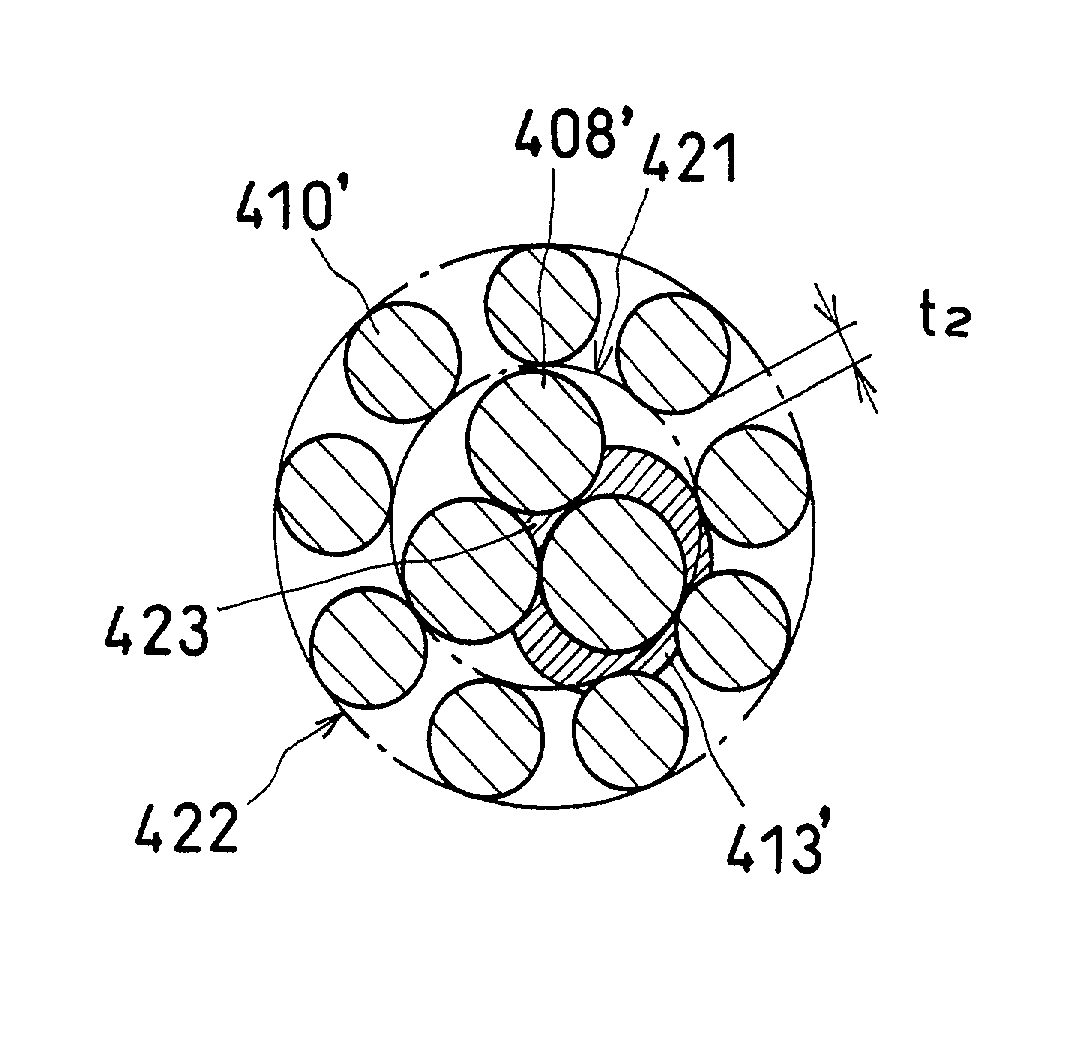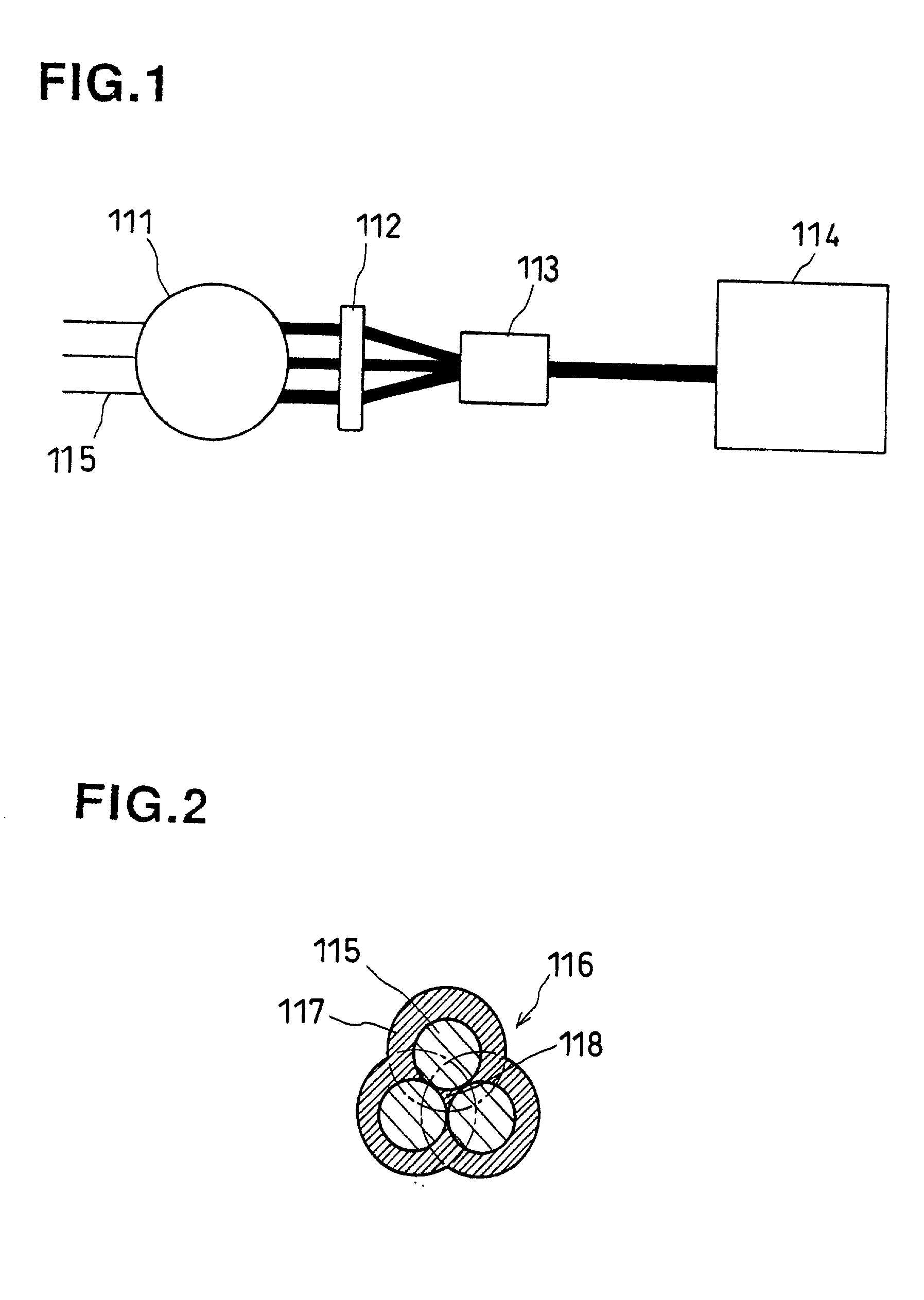Elastomer and steel cord composite and process for producing the same
a technology of elastomer and steel cord, which is applied in the direction of transportation and packaging, chemical instruments and processes, coatings, etc., can solve the problems of shortening the life of tires, reducing fatigue resistance, and large volume of space inside the cord, so as to reduce the time of tire component assembly or the like, energy saving, and low cost
- Summary
- Abstract
- Description
- Claims
- Application Information
AI Technical Summary
Benefits of technology
Problems solved by technology
Method used
Image
Examples
2nd example
[0080] FIG. 3 and FIG. 4 show a process for producing an elastomer and steel cord composite in 2nd Example of the invention. This example is a case of producing a 3 +9 structure of elastomer and steel cord composite. The process comprises a step of forming a core strand (shown in FIG. 3) and a step of stranding outer layer filaments around the core strand (shown in FIG. 4). In FIG. 3, 211 is an uncured rubber coating unit, 212 a wire separator, 213 an inlet die and 214 a buncher (double twist stranding machine). In FIG. 4, 215 is a wire separator, 216 an inlet die and 217 a buncher (double twist stranding machine). All the units are those known per se.
[0081] In the step of forming the core strand as shown in FIG. 3, 3 steel filaments 218 as core filaments are fed in parallel, and supplied toward an inlet of the buncher (double twist stranding machine) 214. During the supply, each of the 3 steel filaments 218 is coated with an uncured rubber through the uncured rubber coating unit 21...
3rd example
[0087] FIG. 7 shows a step of producing an elastomer and steel cord composite in 3rd Example of the invention. This 3rd example is a case of producing a 3 / 9 structure of elastomer and steel cord composite. In FIG. 7, 324 is an uncured rubber coating unit, 325 and 326 wire separators, 327 an inlet die and 328 a buncher (double twist stranding machine). All the units are those known per se.
[0088] In this 3rd Example, 3 steel filaments 329 as core filaments and 9 steel filaments 330 as outer layer filaments are simultaneously fed in parallel such that the 3 steel filaments 329 as core filaments are arranged inside and the 9 outer steel filaments 330 as outer layer filaments are arranged therearound, and supplied toward an inlet of the buncher (double twist stranding machine) 328. During the supply, the uncured rubber is coated on the 3 steel filaments 329 as core filaments with the uncured rubber coating unit 324, passed through the former separator 325, and gathered in the latter wire...
4th example
[0092] FIG. 9 and FIG. 10 show a process for producing an elastomer and steel cord composite in 4th Example of the invention. This example is a case of producing a (3+8) structure of elastomer and steel cord composite. The process comprises a step of forming a core strand (shown in FIG. 9) and a step of stranding outer layer filaments around the core strand (shown in FIG. 10). In FIG. 9, 401 is an uncured rubber coating unit, 402 a wire separator, 403 an inlet die and 404 a buncher (double twist stranding machine). In FIG. 10, 405 is a wire separator, 406 an inlet die and 407 a buncher (double twist stranding machine). All the units are those known per se.
[0093] In the step of forming the core strand as shown in FIG. 9, 3 steel filaments 408 as core filaments are fed in parallel, and supplied toward an inlet of the buncher (double twist stranding machine) 404. During the supply, at least one of the 3 steel filaments 408 is coated with an uncured rubber through the uncured rubber coa...
PUM
| Property | Measurement | Unit |
|---|---|---|
| diameter | aaaaa | aaaaa |
| corrosion resistance | aaaaa | aaaaa |
| fatigue resistance | aaaaa | aaaaa |
Abstract
Description
Claims
Application Information
 Login to View More
Login to View More - R&D
- Intellectual Property
- Life Sciences
- Materials
- Tech Scout
- Unparalleled Data Quality
- Higher Quality Content
- 60% Fewer Hallucinations
Browse by: Latest US Patents, China's latest patents, Technical Efficacy Thesaurus, Application Domain, Technology Topic, Popular Technical Reports.
© 2025 PatSnap. All rights reserved.Legal|Privacy policy|Modern Slavery Act Transparency Statement|Sitemap|About US| Contact US: help@patsnap.com



